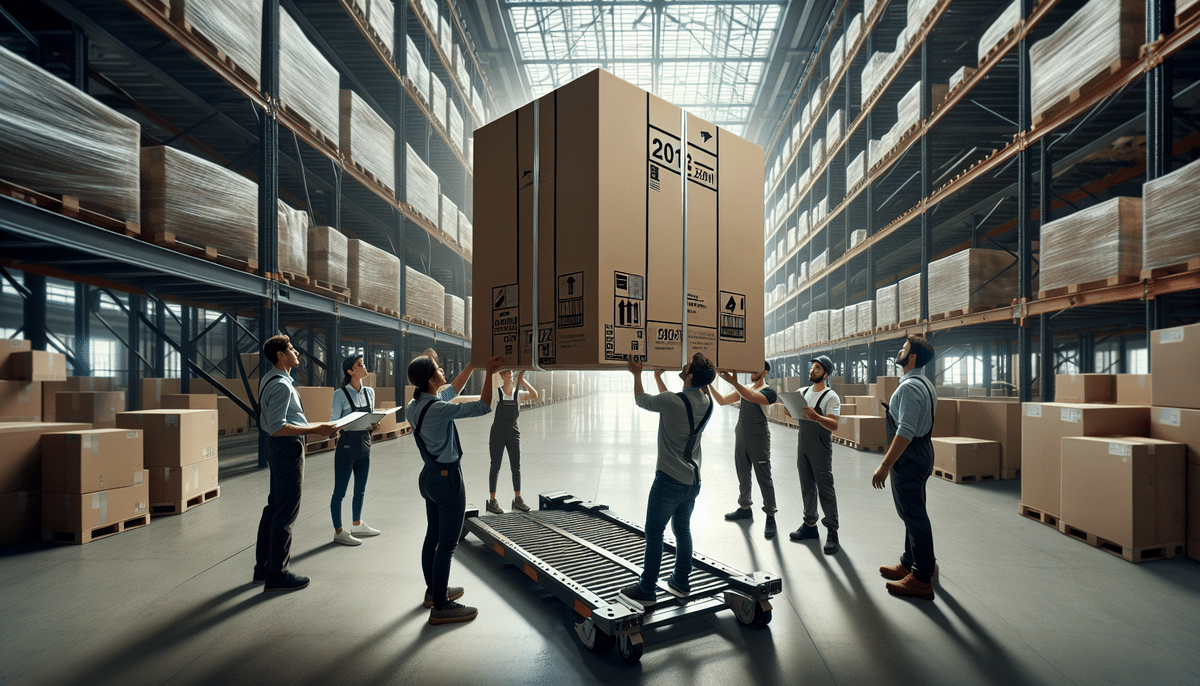How to Handle Packages Over 202 Inches: Additional Handling Tips
Shipping large packages can be a daunting task, especially when the items exceed 202 inches in length and weight. These oversized items require special handling considerations to ensure they are transported safely and efficiently. In this article, we will explore various techniques and tips for managing packages over 202 inches, including selecting appropriate packaging materials, securing and stabilizing items, and maneuvering packages safely. We will also emphasize the importance of proper labeling and documentation, incorporating expert advice and up-to-date industry practices for the safe and efficient handling of large packages.
Understanding the Size and Weight Limits for Packages
Before delving into handling techniques, it is crucial to understand the size and weight limits imposed by major carriers. Most carriers have specific guidelines, and exceeding these limits can result in additional fees or even shipment refusal. For example, according to UPS, the standard limit for package length plus girth (2 x width + 2 x height) is 165 inches, and the maximum weight limit is typically 150 pounds. However, packages exceeding 202 inches classify as oversized shipments, necessitating additional handling considerations.
Different carriers may have varying size and weight restrictions. It's essential to verify the specific requirements with the carrier you intend to use before shipping your package. Additionally, carriers may restrict certain item types, such as hazardous materials or perishable goods. Ensuring compliance with these regulations can prevent unexpected delays and costs.
When preparing your package for shipment, accurately measure and weigh it to confirm it meets carrier guidelines. This proactive step can help avoid additional fees or shipment delays. Utilizing sturdy packaging materials and correctly labeling the package with the recipient's address and necessary shipping instructions are also recommended best practices.
Why Handling Large Packages Requires Extra Attention
Large packages present unique challenges for shippers and carriers due to their size and weight, making them more difficult to maneuver and more susceptible to damage. These packages often require specialized equipment and handling techniques to ensure safe and efficient transport. The additional weight and dimensions can also impose extra stress on carriers' infrastructure, including vehicles, loading docks, and storage facilities. Proper handling techniques are vital to prevent package damage and ensure the safety of carrier staff.
One significant challenge in handling large packages is ensuring they are adequately secured during transport. Improperly secured packages can shift or tip over, causing damage to both the package and potentially injuring carrier staff. Shippers and carriers must use appropriate packaging materials, such as heavy-duty boxes and padding, to immobilize the package during transit.
Beyond physical handling challenges, logistical concerns also arise with large packages. Oversized shipments may require special permits or clearances and might not fit on standard delivery vehicles. Effective logistical planning is essential to ensure timely and intact delivery of oversized packages.
Special Precautions for Packages Over 202 Inches
Handling packages over 202 inches necessitates specific precautions to ensure their safe transport. These precautions include utilizing specialized equipment like forklifts, cranes, or flatbed trucks for loading and unloading. Properly securing and stabilizing the package to prevent movement during transport is essential. Carriers may also require additional packaging materials, such as padding, straps, or corner protectors, to reinforce the package and prevent damage.
Route planning is another critical consideration. Ensure the chosen route is free of obstacles or low-clearance areas that could jeopardize the package's integrity. Depending on the package's size and weight, carriers might require special permits or escorts, adhering to transportation authority regulations.
Clear communication with the carrier regarding the package's size, weight, and any special handling requirements is crucial. This ensures that the carrier is prepared to handle the package safely and efficiently, minimizing delays or damage during transit.
Choosing the Right Packaging Materials for Large Items
Selecting appropriate packaging materials is vital for the safe and efficient transport of large items. Packaging should be sturdy and durable enough to withstand the package's weight and size. Oversized packages may necessitate heavy-duty corrugated cardboard boxes, wooden crates, or custom-made containers. Additionally, packaging must protect the package from external factors like moisture, impact, and temperature fluctuations.
The mode of transportation also influences packaging material choice. For air transport, lightweight materials that endure pressure changes and vibrations are essential. Conversely, sea transport requires materials resilient to saltwater and humidity. According to the International Air Transport Association (IATA), appropriate packaging can significantly reduce damage during transit.
Environmental considerations are increasingly important. Using eco-friendly materials, such as recycled cardboard or biodegradable plastics, can reduce the transportation process's carbon footprint. Additionally, some countries have regulations governing packaging materials for certain products, so compliance is necessary to avoid legal issues.
Tips for Securing and Stabilizing Oversized Packages
Preventing shifting or damage during transport involves carefully securing and stabilizing oversized packages. This can be achieved by using straps, ropes, or chains to anchor the package to a pallet or platform. Employing corner protectors or padding can prevent scratches or dents, and distributing the package's weight evenly helps avoid stress on any single area.
The type of transportation impacts securing methods. For air transport, additional measures like shrink wrapping or vacuum sealing may be necessary to prevent air pressure from causing damage. For truck transport, additional tie-downs or braces can prevent movement during turns or sudden stops.
Proper labeling of oversized packages is equally important. Labels should clearly indicate the package's weight, dimensions, and any special handling instructions. This ensures that carriers handle the package correctly, preventing improper stacking or placement that could lead to damage.
Techniques for Maneuvering Large Packages Safely
Maneuvering large packages safely requires specialized equipment and techniques. Forklifts or pallet jacks are commonly used to move packages within warehouses or loading docks, while cranes or flatbed trucks are employed for loading and unloading. Adhering to proper lifting and handling techniques, such as squatting with the legs instead of bending at the waist, is crucial to prevent injury. Carriers may also mandate the use of specialized equipment or trained personnel for packages exceeding certain weight limits.
Guidelines for Transporting Heavy or Fragile Items
Transporting heavy or fragile items demands extra precautions to prevent damage. Using padding or cushioning protects delicate items, and clearly marking the package as "Fragile" alerts carriers to handle it with care. Depending on the item's nature, temperature-controlled units or dedicated shipments may be necessary to avoid damage from extreme temperatures or pressure fluctuations.
Best Practices for Loading and Unloading Oversized Packages
Loading and unloading oversized packages can be complex and time-consuming. To ensure smooth and safe transport, carriers may require specific guidelines, such as designated loading zones or specific loading and unloading times. Communicating any special requirements or considerations to the carrier in advance helps prevent delays and complications.
How to Store and Handle Large Items in a Warehouse or Storage Facility
Storing and handling large items in a warehouse or storage facility requires meticulous planning and organization. Oversized packages may need designated storage areas or specialized equipment like overhead cranes or hydraulic lifts for safe lifting and movement. Maintaining a detailed inventory of all items and their locations facilitates efficient handling and tracking of packages.
Avoiding Common Mistakes When Handling Large and Heavy Packages
Handling large and heavy packages can be challenging, but many common mistakes are avoidable with proper planning and communication. These mistakes include failing to secure and stabilize the package adequately, exceeding weight or size limits, and neglecting proper labeling or documentation. By adhering to guidelines and communicating with carriers ahead of time, many potential complications can be prevented.
The Importance of Proper Labeling and Documentation for Oversized Shipments
Accurate labeling and thorough documentation are essential for the safe and efficient transport of oversized shipments. Proper labeling, which includes the package's weight, size, and fragility, alerts carriers to take necessary precautions and ensures appropriate handling. Comprehensive documentation, such as detailed inventories and tracking information, helps prevent loss or damage and provides crucial information in case of incidents.
How to Address Customer Concerns About Shipping Large Items
Shipping large items often raises customer concerns about potential damage, delays, or additional fees. Addressing these concerns requires clear and transparent communication regarding the package's handling and transport processes. Providing detailed tracking information, estimated delivery times, and information about the carrier's handling procedures can alleviate customer worries and build trust.
The Role of Technology in Managing Oversized Package Logistics
Technology plays a pivotal role in managing the logistics of oversized packages. Tracking and inventory management systems offer real-time information on package location and condition, enhancing visibility and control. Additionally, route optimization software can minimize transportation costs while ensuring safe and efficient handling. Advanced technologies like Shipscience's logistics solutions aid in streamlining oversized package management.
Conclusion: Expert Tips and Advice for Safe and Efficient Handling of Large Packages
Handling large packages requires specialized equipment and meticulous planning to ensure safe and efficient transport. By following established guidelines and proactively communicating with carriers, many potential issues can be avoided. We hope this article has provided valuable tips and expert advice for the safe and efficient handling of large packages, ensuring that your next oversized shipment proceeds smoothly and successfully.






















